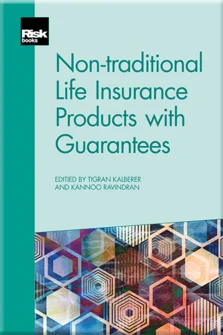Risks Faced by Writers of Investment Guarantees
Daren Lockwood and Matt Cheung
Low Interest Rate Environments and Consequences
Risks Faced by Writers of Investment Guarantees
Variable Annuity in Asia post-2008
How did Variable Annuities Fare in the Crisis?
Traditional Life Insurance Products are Under Pressure
An Overview of Regulatory Requirements
Simulations
Economic Scenario Generators and Variable Annuities
Modelling and Managing Policyholder Behavioural Risks
Modelling and Managing Mortality and Longevity Risks
Valuation of Variable Annuity Guarantees
Understanding and Using Reinsurance Treaties for Guaranteed Products
Hedging of Long-term Fund-linked Exotic Options
Overview of Commonly Used Risk Management Strategies
Taxonomy of Equity, Interest Rate, Hybrid and Customised Derivatives Used for Risk Management
Managing Risks Underlying Variable Annuity Liabilities
Basis Risk
Measuring Hedge Effectiveness
Measuring and Reporting Hedge Efficiency
Eight Important Questions Practitioners Should Ask When Managing Equity-linked Insurance Guarantee Risks
Life insurers commonly provide policyholders with investment guarantees – for example, as a feature of variable annuity (VA) products. These investment guarantees are widely recognised as embedded options, both in accounting treatments and in the approaches generally used by issuers to manufacture the guarantees. In particular, issuers tend to make use of liquid hedge instruments available in the capital markets to fund the guarantees and manage their risk exposures.
These embedded options differ in character from liquid options traded in the capital markets in a number of key respects. For instance, they are often exotic in nature, with significant customisation by the issuer. They also often have higher maturities than the options available in the liquid options market. The underlying for guarantees can be a complex basket of investments with significant basis risk compared to the closest mix of liquid hedge instruments. In addition, although risks associated with policyholder utilisation of the options can sometimes be transferred – for example, through reinsurance deals or mergers and acquisitions (M&A) transactions – information about policyholder behaviour is more limited
Copyright Infopro Digital Limited. All rights reserved.
As outlined in our terms and conditions, https://www.infopro-digital.com/terms-and-conditions/subscriptions/ (point 2.4), printing is limited to a single copy.
If you would like to purchase additional rights please email info@risk.net
Copyright Infopro Digital Limited. All rights reserved.
You may share this content using our article tools. As outlined in our terms and conditions, https://www.infopro-digital.com/terms-and-conditions/subscriptions/ (clause 2.4), an Authorised User may only make one copy of the materials for their own personal use. You must also comply with the restrictions in clause 2.5.
If you would like to purchase additional rights please email info@risk.net











